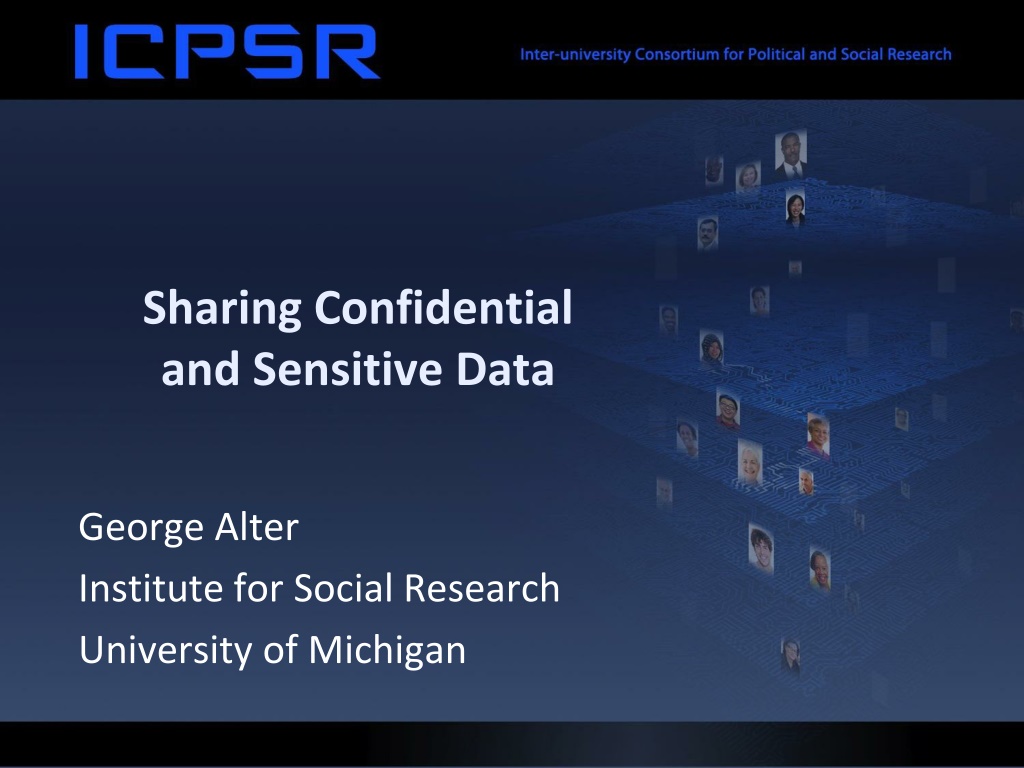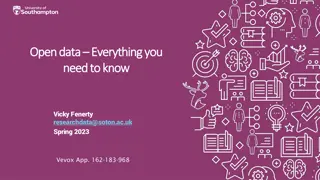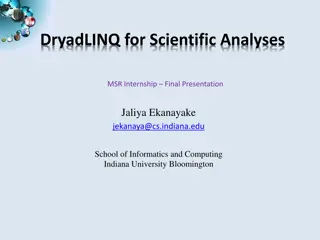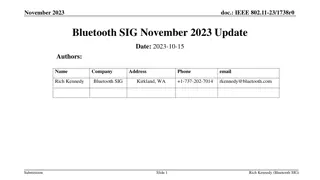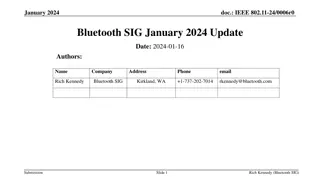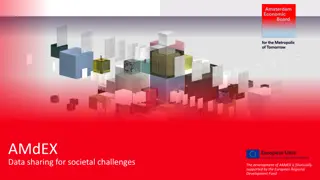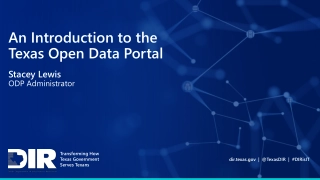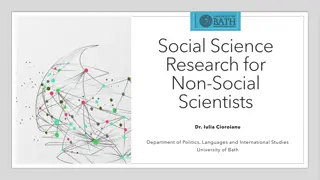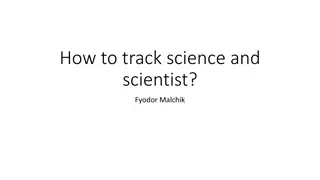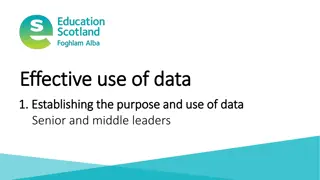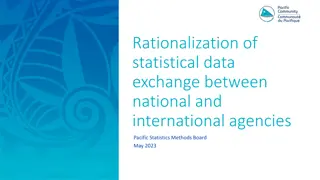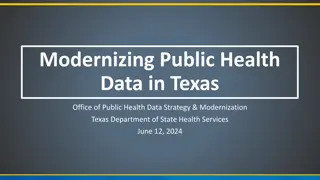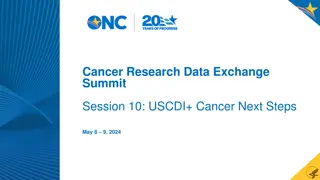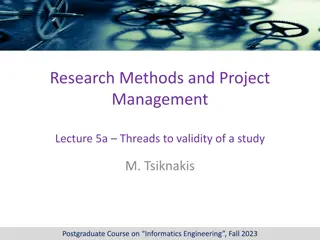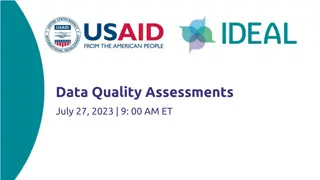Understanding the Importance of Data Sharing in Scientific Research
Data sharing plays a crucial role in scientific research to uphold transparency, reproducibility, and legitimacy. Skepticism of science due to fraud, publication bias, and challenges underscores the necessity for sharing confidential data. Professional associations, funding agencies, and journals advocate for data sharing to promote research transparency and integrity.
Download Presentation
Please find below an Image/Link to download the presentation.
The content on the website is provided AS IS for your information and personal use only. It may not be sold, licensed, or shared on other websites without obtaining consent from the author. Download presentation by click this link. If you encounter any issues during the download, it is possible that the publisher has removed the file from their server.
Presentation Transcript
Sharing Confidential and Sensitive Data George Alter Institute for Social Research University of Michigan
About me Research Professor Emeritus, Institute for Social Research, University of Michigan Research specialty is historical demography and the history of the family Recent work on data sharing and metadata standards Former director of ICPSR, world s largest social science data archive
Outline 1. Why is data sharing a big deal right now? 2. How do we share confidential data? 3. Data Repositories
Outline 1. Why is data sharing such a big issue? Skepticism of science Well-publicized cases of fraudulent data Publication bias Defending the legitimacy of science FAIR: Findable, Accessible, Interoperable, Reusable
Skepticism of Science Challenges to science Fraud and Mistakes Publication bias
Skepticism of Science Challenges to science Fraud and Mistakes Publication bias
Publication Bias Distribution of z-scores for coefficients reported in the APSR and the AJPS. p-value = 0.05 Alan Gerber and Neil Malhotra, "Do Statistical Reporting Standards Affect What Is Published? Publication Bias in Two Leading Political Science Journals," Quarterly Journal of Political Science, 2008, 3: 313 326.
How do we defend the legitimacy of science? What distinguishes the voice of science from every other voice on TV, radio, Internet, ? Science has norms and ethics: Transparency Reproducibility Who promotes these norms? Professional associations Funding agencies Journals
Data Access and Research Transparency Professional associations are making data sharing an ethical standard Data sharing is required by funding agencies NIH, NSF, Gates Many journals require deposit of data and program code in a trusted repository
Research Transparency is Ethical Research 6. Researchers have an ethical obligation to facilitate the evaluation of their evidence based knowledge claims through data access, production transparency, and analytic transparency so that their work can be tested or replicated. 6.1 Data access: Researchers making evidence-based knowledge claims should reference the data they used to make those claims. If these are data they themselves generated or collected, researchers should provide access to those data or explain why they cannot. 6.2 Production transparency: Researchers providing access to data they themselves generated or collected, should offer a full account of the procedures used to collect or generate the data. 6.3 Analytic Transparency: Researchers making evidence- based knowledge claims should provide a full account of how they draw their analytic conclusions from the data, i.e., clearly explicate the links connecting data to conclusions.
Findable, Accessible, Interoperable, Reusable (FAIR) Requirements Metadata following community standards Persistent identifiers (e.g. DOIs) Searchable Indexes (DataONE, bioCADDIE, Dataverse, Schema.org) Data usage licenses Data citation Trusted Digital Repositories
Findable, Accessible, Interoperable, Reusable (FAIR) FAIR is about making data accessible by machines Persistent identifiers (PIDs) Allow machines to find: Data Definitions of variables Code lists URLs change frequently PIDs point to a registry with the current URL Benefits: Suppose that you could write a short program that would harvest data from every country in the world into one merged data set
Outline 2. How do we share confidential data? Confidentiality and ethical research Why isn t HIPAA enough? What are we afraid of? Five Safes Gradient of risk and harm Data use agreements Data repositories
Confidentiality and Ethical Research What do we promise when we conduct research about people? That benefits (usually to society) outweigh risk of harm (usually to individual) That we will protect their privacy Data sharing is an obligation to our subjects Subjects want the benefits that science can bring They want their data to be re-used
Why is confidentiality so important? People may give us information that could harm them if revealed. Examples: medical conditions, criminal activity, unpopular opinions, ... Many subjects are wary about commercialization of their personal information
Why isnt HIPAA enough? HIPAA is not suited to complex data De-identification in HIPAA is focused on removing direct identifiers name, address, SSN, telephone number, etc. HIPAA did not anticipate: Deductive disclosure: Combination of multiple indirect identifiers Information that is easily available on the Internet Growth and accessibility of computing power DNA sequencing, facial recognition, machine learning,
Who are We Afraid of? Parents trying to find out if their child had an abortion or uses drugs Spouse seeking hidden income or infidelity in a divorce Insurance companies seeking to eliminate risky individuals Other criminals and nuisances NSA, CIA, FBI, KGB, SABOT, SBL, SMERSH, KAOS, etc...
Deductive Disclosure A combination of characteristics could allow an intruder to re-identify an individual in a survey deductively, even if direct identifiers are removed. Dependent on Knowing someone in the survey Matching cases to a database
Protecting Confidential Data A menu of measures that reinforce each other: Safe data: Modify the data to reduce the risk of re-identification Safe projects: Review research plans Safe settings: Physical isolation and secure technologies Safe people: Data use agreements and Training Safe outputs: Results are reviewed before being released to researchers
Safe Data Removing identifiers Data masking Grouping values Top-coding Aggregating geographic areas Swapping values Suppressing unique cases Sampling within a larger data collection Adding noise Replacing real data with synthetic data
Safe Projects Researchers submit a research plan Research plan is reviewed for Feasibility: Can it be accomplished with these data? Consent: Is the research consistent with informed consent of subjects? Merit: Review by an independent, neutral panel of experts
Safe Settings Data Protection Plans Data recipients must explain how they will protect against unauthorized use, theft, loss, hacking, etc. Remote submission and execution User submits program code or scripts, which are executed in a controlled environment Virtual data enclave Remote desktop technology prevents moving data to user s local computer Physical enclave Users must travel to the data
The Virtual Data Enclave (VDE) provides remote access to quantitative data in a secure environment.
Safe people Data Use Agreements Parts of a data use agreement at ICPSR Research plan IRB approval Data protection plan Behavior rules Security pledge Institutional signature Training in disclosure risks
Data archive Interview Data Use Agreement Institution Data Protection Plan Informed Consent Data flow Data Dissemination Agreement Research Plan Researcher IRB Approval Data producer
Data Use Agreement: Behavior rules To avoid inadvertent disclosure of persons, families, households, neighborhoods, schools or health services by using the following guidelines in the release of statistics derived from the dataset. 1. In no table should all cases in any row or column be found in a single cell. 2. In no case should the total for a row or column of a cross-tabulation be fewer than ten. 3. In no case should a quantity figure be based on fewer than ten cases. 4. In no case should a quantity figure be published if one case contributes more than 60 percent of the amount. 5. In no case should data on an identifiable case, or any of the kinds of data listed in preceding items 1-3, be derivable through subtraction or other calculation from the combination of tables released.
Safe People: Disclosure risk online tutorial Disclosure: Graph with extreme values example Data were collected for a sample of 104 people in a county. Among the variables collected were age, gender, and whether the person was arrested within the last year. Box plots below show the distribution of age, one plot for those arrested and one for those who were not. The number labels are case number in the dataset. The potential identifiability represented by outlying values is compounded here by an unusual combination that could probably be identified using public records for a county in the U.S. --someone approximately 90 years old was arrested in the sample. Including extreme values is a disclosure risk for identifiability when combined with other variables in the dataset. Arrested in last year? no yes N min age max age mean age std dev % female % arrested 104 12 95 51 15 5.2 5.8
Safe outputs Controlled environments allow review of outputs o Remote execution systems, Virtual data enclaves, Physical enclaves Disclosure checks may be automated, but manual review is usually necessary
Balancing Costs and Benefits Data protection has costs Modifying data affects analysis Access restrictions impose burdens on researchers Protection measures should be proportional to risks Two dimensions of risk 1. Probability that an individual can be re-identified 2. Severity of harm resulting from re-identification
Gradient of Risk & Restriction High Risk Enclosed Data Center identifiable High severity of harm & highly Moderate Risk - Strong DUA & Technology Rules Complex data: moderate harm & re-identifiable with difficulty Severity of Harm Complex Data: low harm & low probability of disclosure Some Risk Data Use Agreement Simple Data: minimal harm & very low chance of disclosure Tiny Risk Web Access Probability of Disclosure
3. Data Repositories What should we expect from data repositories? Certification of trusted digital repositories Examples: Vivli dbGaP ICPSR Data citation
What should we expect from data repositories? Scientific data should be Discoverable Searchable catalog Meaningful Curated and documented Usable Accessible in non-proprietary formats Citable Citations with persistent identifiers Trustworthy Transparent procedures Persistent Sustainable organizations
Trusted Digital Repositories are certified 16 guidelines Self-assessment with peer review 70+ certified Archaeology, environmental science, geoscience, oceanography, seismology, social sciences, space science, traumatic brain injury research, Based on Trustworthy Repositories Audit & Certification: Criteria and Checklist (TRAC) 100+ criteria ISO 16363
Data sharing and analytics platform for clinical trials Non-profit that brings together data from both academic and private industry Members include AstraZeneca, Bayer, Biogen, Johnson & Johnson, Lilly, Pfizer Studies available from members are listed in the Vivli catalog Remote access and analysis model Data remain on secure servers at Vivli Access procedure Data contributor checks feasibility of request Independent Review Panel evaluates merits of research proposal Data Use Agreement between Vivli and researcher s university
Genomic data NIH funded researchers are required to deposit genomic data in dbGaP Access to dbGAP data Access is approved for a specific project Reviewed by an NIH Data Access Committee Institution must sign Data Use Certification dbGaP data often come with limitations Research may be limited by disease, methodology, geography, etc. Study data may not be used to investigate individual participant genotypes, individual pedigree structures, perceptions of racial/ethnic identity, non-maternity/paternity, and of variables that could be considered as stigmatizing an individual or group.
ICPSR has biomedical data too! Spinal Cord Injury Rehabilitation Study, United States, 2007-2010 (ICPSR 36724) National Longitudinal Study of Adolescent to Adult Health (Add Health), 1994-2018 (ICPSR 21600) Population Assessment of Tobacco and Health (PATH) Study (ICPSR 36498) Collaborative Psychiatric Epidemiology Surveys (CPES), 2001-2003 [United States] (ICPSR 20240) National Comorbidity Survey: Reinterview (NCS-2), 2001-2002 (ICPSR 35067) National Health and Nutrition Examination Survey (NHANES), 2007- 2008 (ICPSR 25505) National Study of Physician Organizations (NSPO3), United States, 2012-2013 (ICPSR 38587)
Thank you George Alter altergc@umich.edu
